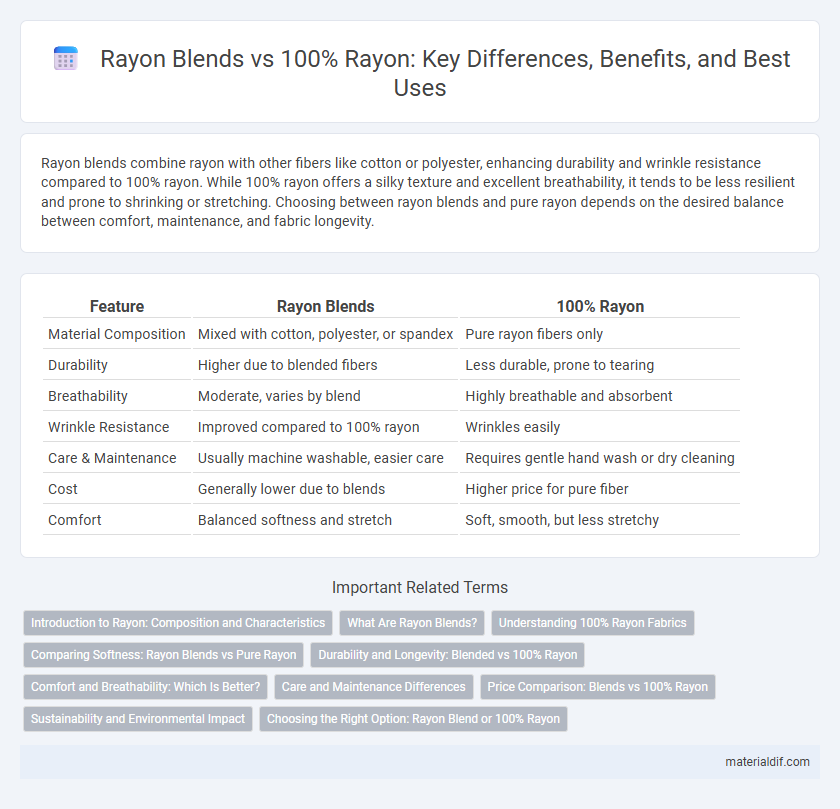Rayon blends combine rayon with other fibers like cotton or polyester, enhancing durability and wrinkle resistance compared to 100% rayon. While 100% rayon offers a silky texture and excellent breathability, it tends to be less resilient and prone to shrinking or stretching. Choosing between rayon blends and pure rayon depends on the desired balance between comfort, maintenance, and fabric longevity.
Table of Comparison
| Feature | Rayon Blends | 100% Rayon |
|---|---|---|
| Material Composition | Mixed with cotton, polyester, or spandex | Pure rayon fibers only |
| Durability | Higher due to blended fibers | Less durable, prone to tearing |
| Breathability | Moderate, varies by blend | Highly breathable and absorbent |
| Wrinkle Resistance | Improved compared to 100% rayon | Wrinkles easily |
| Care & Maintenance | Usually machine washable, easier care | Requires gentle hand wash or dry cleaning |
| Cost | Generally lower due to blends | Higher price for pure fiber |
| Comfort | Balanced softness and stretch | Soft, smooth, but less stretchy |
Introduction to Rayon: Composition and Characteristics
Rayon blends combine rayon with fibers like cotton, polyester, or spandex to enhance durability, stretch, and comfort, providing versatile fabric options with improved performance. In contrast, 100% rayon exhibits a soft, breathable texture derived from regenerated cellulose fibers, prized for its smooth drape and moisture-absorbent qualities. Understanding the composition and characteristics of rayon versus its blends aids in selecting the ideal fabric for specific applications, balancing aesthetics, feel, and functional properties.
What Are Rayon Blends?
Rayon blends combine rayon fibers with materials such as cotton, polyester, or spandex, enhancing durability, stretch, and wrinkle resistance compared to 100% rayon. These blends maintain rayon's softness and breathability while improving fabric performance for diverse apparel applications. Rayon blends offer versatile textile solutions by balancing comfort and resilience in clothing and home textiles.
Understanding 100% Rayon Fabrics
100% rayon fabrics offer a soft, breathable, and smooth texture that closely mimics natural fibers like cotton and silk, making them ideal for comfortable, lightweight clothing. Compared to rayon blends, 100% rayon provides better moisture absorption and drapes more fluidly, enhancing both comfort and style. However, pure rayon requires careful washing and maintenance to prevent shrinking and maintain fabric integrity.
Comparing Softness: Rayon Blends vs Pure Rayon
Rayon blends combine rayon with fibers like cotton or polyester, often enhancing durability while slightly reducing the pure softness characteristic of 100% rayon. Pure rayon offers a smoother, silkier feel due to its high cellulose content, making it notably softer against the skin compared to blended fabrics. Consumers seeking maximum softness typically prefer 100% rayon, whereas blends offer a balance of softness and strength.
Durability and Longevity: Blended vs 100% Rayon
Rayon blends often exhibit enhanced durability and longevity compared to 100% rayon due to the integration of stronger fibers like polyester or cotton, which provide resistance against wear and tear. In contrast, 100% rayon fabrics tend to be more delicate and prone to stretching, shrinking, and wrinkling, reducing their lifespan with frequent use and washing. Blended rayon materials maintain the soft, breathable qualities of rayon while improving overall fabric strength and resilience for extended garment life.
Comfort and Breathability: Which Is Better?
Rayon blends often combine fibers like cotton or polyester, enhancing durability and moisture-wicking properties while maintaining softness, but 100% rayon typically offers superior breathability and a smoother, silk-like feel against the skin. The high absorbency and natural fiber structure of pure rayon allow for better air circulation, making it more comfortable in warm and humid conditions. However, rayon blends might provide improved wrinkle resistance and easier care, balancing comfort with practicality.
Care and Maintenance Differences
Rayon blends often require less delicate care compared to 100% rayon, as the mixed fibers can enhance durability and reduce wrinkling, making them easier to machine wash and maintain. In contrast, 100% rayon garments typically demand gentle hand washing or dry cleaning to prevent shrinkage, warping, or fabric weakening. Proper care for each type is essential to extend garment life and preserve texture, with rayon blends generally offering a more convenient maintenance routine.
Price Comparison: Blends vs 100% Rayon
Rayon blends typically offer a more affordable price point compared to 100% rayon fabrics due to the combination of rayon with cost-effective fibers like polyester or cotton. The inclusion of synthetic or natural fibers reduces manufacturing costs while retaining rayon's soft texture and drape. Consumers often find rayon blends provide a budget-friendly alternative without sacrificing the look and feel of pure rayon.
Sustainability and Environmental Impact
Rayon blends often incorporate synthetic fibers like polyester, reducing overall biodegradability and increasing microplastic pollution compared to 100% rayon, which is derived from natural cellulose and is more eco-friendly when processed responsibly. However, 100% rayon production typically demands significant water and chemical use, making sustainable harvesting and closed-loop manufacturing essential to minimizing environmental impact. Choosing certified sustainable rayon or blends with organic fibers can further enhance environmental benefits by lowering resource consumption and reducing toxic emissions.
Choosing the Right Option: Rayon Blend or 100% Rayon
Rayon blends combine rayon fibers with materials like cotton or polyester to enhance durability, wrinkle resistance, and breathability, making them ideal for everyday wear and easy maintenance. 100% rayon offers a softer, more luxurious texture with excellent moisture absorption, perfect for lightweight, flowy garments but may require careful handling due to its tendency to wrinkle and shrink. Choosing between rayon blends and 100% rayon depends on lifestyle needs and fabric performance preferences, balancing comfort, durability, and care requirements.
Rayon Blends vs 100% Rayon Infographic

 materialdif.com
materialdif.com